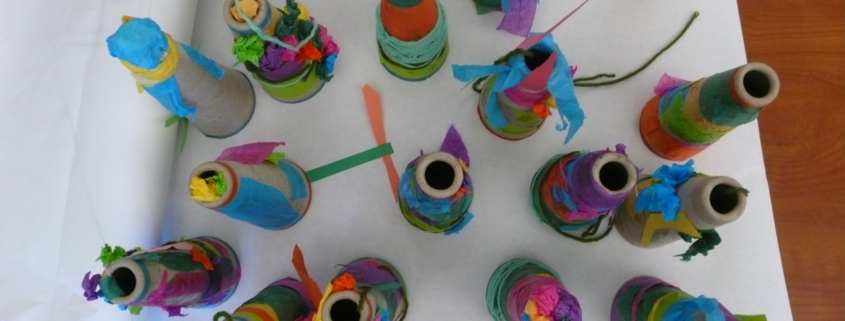Let’s Put on a Play
In Ross Gay’s poem, To the Fig Tree on 9th and Christian, a group of pedestrians spontaneously gather around a fig tree and begin to savor the figs together. “Strangers maybe never again,” Gay writes. I think about this poem often; how good it makes me feel when I read it aloud. I love the image of the community spontaneously forming on the sidewalk. It is a feeling of safety and joy that I work to cultivate throughout my life.
* * *
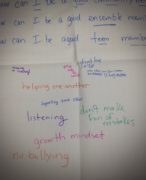 In 2009, I am thirty-three and working with a group of fifth and sixth graders. Our daily class begins at 3 p.m. when they are explosive. They are sometimes angry at each other or their teachers or at the unfairness inherent in being a child inside a school building. This frenzy is how their bored confusion manifests at the end of a school day. The anger sometimes turns to tantrum, a form of acting out/testing boundaries. They mock one another with glee and are easily hung up on any provocation, silliness or tangent. They love to waste time by asking nonsense questions and playing around. I often sit through this and engage them, allowing one to throw himself on the floor and spin around, or listening to an argument about who did what to whom. I try to be present for them and to engage them in some critical conversation, or distract them with the day’s planned activity. We spend the afternoon working on our mask-making project, practicing the skill of being part of a creative community. By the end of the day, they have relaxed and hopefully feel good about their work.
In 2009, I am thirty-three and working with a group of fifth and sixth graders. Our daily class begins at 3 p.m. when they are explosive. They are sometimes angry at each other or their teachers or at the unfairness inherent in being a child inside a school building. This frenzy is how their bored confusion manifests at the end of a school day. The anger sometimes turns to tantrum, a form of acting out/testing boundaries. They mock one another with glee and are easily hung up on any provocation, silliness or tangent. They love to waste time by asking nonsense questions and playing around. I often sit through this and engage them, allowing one to throw himself on the floor and spin around, or listening to an argument about who did what to whom. I try to be present for them and to engage them in some critical conversation, or distract them with the day’s planned activity. We spend the afternoon working on our mask-making project, practicing the skill of being part of a creative community. By the end of the day, they have relaxed and hopefully feel good about their work.
* * *
Creative communities have made me who I am today: a person, an artist, who wants to nourish and mentor healthy happy communities of youth. Funding for creative communities often comes from NEA, NEH, or 21st Century Learning, which the new national budget seeks to butcher or eliminate.
Trump’s budget cuts show how little he cares for the safe development of children, not just the children he openly despises—brown, black, immigrant—but all children, because all children benefit from the programs that will be cut. According to The Washington Post, in 2016, the NEA and NEH each received about 0.003% of the overall federal budget. This money funds a vast array of programs all over the country.
Take the Arts Education Partnership for example, which works so that, “by the year 2020, every young person in America, at every grade level, will have equitable access to high quality arts learning opportunities, both during the school day and out-of-school time.”
* * *
I am five years old in a Montessori classroom. I get to choose whether I want to play with blocks, read, or play outside. I play with other children in an unstructured way.
*
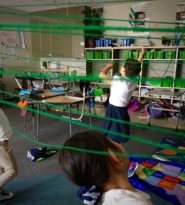 I am seven years old. Both my parents work. My cousins and I attend YMCA summer camp in Staten Island. We play outside. We swim. We put on plays every single day.
I am seven years old. Both my parents work. My cousins and I attend YMCA summer camp in Staten Island. We play outside. We swim. We put on plays every single day.
*
I am ten years old. On the weekends and some weekdays, I attend rehearsals for community theater. I fit in here more than I do with kids in my elementary and later, middle schools. I laugh, play, memorize lines and am mentored by older kids and full grown adults. I make friends that I still know thirty years later.
*
I am thirteen years old, attending LaGuardia High School for the performing Arts, a magnet school where I meet kids from all over New York City. We rehearse for five months of senior year for our final productions. Over that time, the cast and crew members of each production become tight-knit caring communities.
*
I am nineteen in a study abroad program. The twenty students are an unlikely community from all over the United States. Throughout the year, we visit communities throughout Mexico to learn about their activism. I learn about myself and relating to others, and to speak Spanish. I bring this learning into all my future work environments.
* * *
Twenty-five years old to present, I work as a teaching artist in after-school programs that are free for students in New York City and Seattle. Most programs I have worked with are connected to public schools. Parents are grateful that their kids have a place to go while they are at work. They report that their children love the programs. I watch students grow emotionally, creatively and academically through participating in a variety of artistic disciplines. Most of the students I work with are poor or working class. Over half are immigrants or children of immigrants. I know that these programs exist all over the country and all over the country, they serve poor and working class students and families.
* * *
I am enrolled in the MFA program at Antioch University Los Angles and I serve as Creative Nonfiction editor of this journal. These writing communities help me to feel connected and encourage me throughout each semester. Coming together twice a year for residencies is challenging. We don’t all know each other and, even though we are all writers, we are very different types of people; but ultimately, I come away from each residency feeling very full. Ready.
* * *
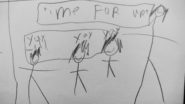 Every moment of teaching is like a new experiment with the guiding question, who can I be in this world? Much of any student’s reactionary behavior is based in the assumption: “I cannot be anything in this world.” Our culture doesn’t seem to give students much choice beyond what they see on television—depictions of people who look like them portrayed by racist media. They see self-worth associated with money, power and violence.
Every moment of teaching is like a new experiment with the guiding question, who can I be in this world? Much of any student’s reactionary behavior is based in the assumption: “I cannot be anything in this world.” Our culture doesn’t seem to give students much choice beyond what they see on television—depictions of people who look like them portrayed by racist media. They see self-worth associated with money, power and violence.
That time, between 3 and 6 p.m. is when we help them experiment with who they can and might be. This describes many of the programs I have taught in. What my colleagues and I do is create a safe community for youth to be themselves, to create and to think critically. After-school programs range from arts to academics to sports to pure daycare. Every program I have worked in has nurtured a community among students. It is no wonder I have chosen to return to these environments. They contain the elements that nurtured me from an early age, starting with Montessori school.
* * *
Because big city museums and art organizations often have multiple funding sources, including large corporations and trendy local businesses, the arts in rural areas will be more sharply affected by the NEA cuts. According to a Quartz article, “cutting federal support for the arts will have the greatest impact in rural areas and on the vast swath of America that sits between its coasts.”
I once attended a 21st Century Learning conference in Albany, NY. Most of the after-school providers were from New York City, with some from rural areas in New York State. On panels and in private conversations, they shared how their youth lacked enrichment activities and how funding was too short to serve all the youth who needed to be engaged. Coming from the city, this was a new perspective for me. Arts education has been my anchor for as long as I can remember. Rural areas might not have the plethora of opportunities that I took for granted, that have helped me to grow throughout my life.
The cuts to 21st Century Learning, which serves children in all 50 states—over one hundred thousand in Texas alone—are devastating. According to an article in Youth Today, “Thousands of after-school programs serving low-income kids across the country could sink or be injured.”
Combined cuts to NEA and DOE will directly and indirectly affect hundreds of thousands of children throughout the country. Here is an example from LA in The Daily News:
L.A.’s Best… organizes after-school programs for about 25,000 kids in Los Angeles, serving them snacks, involving them in activities and helping with homework. Eric Gurna, president and CEO of the organization, which is housed in the Mayor’s Office, said L.A.’s Best could be affected indirectly by cuts in federal arts funding, after it passes through the state.
Oh right. that’s another thing. Almost every afterschool program feeds children.
It feels important to mention that the NEA also funds programs like Creative Forces, which works with the Military Healing Arts Network to:
… place creative arts therapies at the core of patient-centered care at 11 clinical sites throughout the country, plus a telehealth program, and increases access to therapeutic arts activities in local communities for military members, veterans, and their families. These programs serve the unique and special needs of military patients who have been diagnosed with traumatic brain injury and psychological health conditions.
So while the proposed budget increases military spending, it cuts the programs that have proven beneficial to veterans, which reveals a type of violence underlying the new proposed budget.
* * *
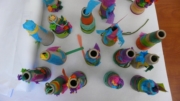 As a young person, I was privileged to be surrounded by opportunities to be part of creative communities. My priorities in life are a result: I want youth to have lots of opportunities. I am angry and I want more than simply to fight against these cuts. I want our communities to be represented by a government that puts people over profit. The goals of capitalism are at odds with our well-being. This was true before Trump and it is true now. I do not want the funding to be cut, but if our communities will not be funded, we will work to keep them thriving.
As a young person, I was privileged to be surrounded by opportunities to be part of creative communities. My priorities in life are a result: I want youth to have lots of opportunities. I am angry and I want more than simply to fight against these cuts. I want our communities to be represented by a government that puts people over profit. The goals of capitalism are at odds with our well-being. This was true before Trump and it is true now. I do not want the funding to be cut, but if our communities will not be funded, we will work to keep them thriving.
In a talk at Antioch University Los Angeles in 2016, the poet Fred Moten told us that “sharing is way more complicated and interesting than killing.” I think about this now in light of brutal cuts to arts funding, how they seek to injure the idea of community. “My poetry is concerned with what we do,” he said, as opposed to what the oppressors are doing. What we do is share, not kill, and that is where we need to hold our focus, not on their violence, but on our love. I am using this to guide me, both in my objection to the budget cuts, but also in my future actions.
I am not sure why Ross Gay’s words return to me now. Perhaps because I typed an expletive before the name Trump and then deleted it because this is about what WE do. This is about us and our “gleeful eating out of each other’s hands.”
That is where I want to take this. Let’s go to the fig tree. Let’s eat and talk and work though our differences, and then let’s put on a play.
 Meredith Arena is from New York City and resides in Seattle where she works as a teaching artist in the public schools and facilitates meditation for adults. She is a student in the MFA program at Antioch University Los Angeles. She is a Creative Nonfiction Editor on Lunch Ticket. Her work has appeared in Entropy, Lunch Ticket and SHIFT Queer Literary Arts Journal.
Meredith Arena is from New York City and resides in Seattle where she works as a teaching artist in the public schools and facilitates meditation for adults. She is a student in the MFA program at Antioch University Los Angeles. She is a Creative Nonfiction Editor on Lunch Ticket. Her work has appeared in Entropy, Lunch Ticket and SHIFT Queer Literary Arts Journal.

